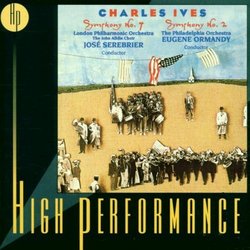| All Artists: Charles Ives, Eugene Ormandy, José Serebrier, London Philharmonic Orchestra, Philadelphia Orchestra Title: Charles Ives: Symphonies Nos. 2 & 4 Members Wishing: 2 Total Copies: 0 Label: RCA Release Date: 8/10/1999 Genre: Classical Styles: Historical Periods, Modern, 20th, & 21st Century, Symphonies Number of Discs: 1 SwapaCD Credits: 1 UPCs: 090266331628, 090266331628, 009026633162 |
Search - Charles Ives, Eugene Ormandy, José Serebrier :: Charles Ives: Symphonies Nos. 2 & 4
 | Charles Ives, Eugene Ormandy, José Serebrier Charles Ives: Symphonies Nos. 2 & 4 Genre: Classical |
Larger Image |
CD Details |
CD ReviewsThis disc is worth ten-thousands words (of praise! ). David A. Hollingsworth | Washington, DC USA | 11/29/1999 (5 out of 5 stars) "Charles Ives (1874-1954) was as daring of a modern giant as Denmark's Carl August Nielsen (1865-1936) or even Bela Bartok (1880-1945). When looking at Ives, Nielsen and Bartok, I realize from the onset that there's very little comparisons between them. The three composers began composing works along tradition lines, although their individual stamp are already established. As their careers progressed, these composers established their idiom and means expressionism progressed ahead of their time. They became very experimental for the sake of giving art a new face. Nielsen became more neoclassical whereas Ives used more of polyrhythms (different instrumental groups playing different tunes at different rhythms simutaneously-which Nielsen used in Act II's A beautiful square in Isfahan of his incidental score "Aladdin"-but not as complexed as Ives). Bartok's Three Village Scenes are as complexed as Ives' Three Places in New England, with the constant changes of rhythms and experiments with atonality. Ives' Fourth Symphony, arguably his most complex work, is among his compositions experimenting with poly-rhythms. What made Ives a great composer was the personal and original message he was able to express (the same must said of Nielsen and Bartok). It is the orginality never witnessed before and Ives is deemed as the most independant Amercian composer, and rightfully so! Even the wonderfully patriotic Second Symphony of 1902 employs multi-rhythms towards its'end.The originality of both Nielsen and Ives caused them the lack of understanding and appreciation among music lover: only to be reversed posthumously. It was only the handful of conductors (Bernstein, Ormandy, Serebrier, later Tilson-Thomas, Jarvi, and Ozawa) who had the courage and enthusiasm in performing the Ives' works for the sake of promoting them to the much larger audiences. Rehearsing Ives' later works proved difficult. Even Jose Serebrier (in the program notes) admitted 12 sectional rehearsals needed in five recording sessions of the Fourth Symphony. Listening to this disc, Serebrier's 1974 performance of Ives' Fourth Symphony with the London Philharmonic is by far the best on record (though Ozawa's performance with the Boston Symphony is marginally close). The orchestra is highly responsive under Serebrier's firm hand and great sense of balance in especially the most difficult of passages (mainly in the 2nd and 4th movements).Equally enticing is the 1974 performance of Ives' Second Symphony under Ormandy and the Philadelphia Orchestra. Like Bernstein and the New York Philharmonic, Ormandy and the Philadelphia Orchestra played with emotional zest and uppermost pride. Unlike Tilson-Thomas and the Royal Concergtebouw, Ormandy and Bernstein achieved greater balance and discipline in performing Ives' Second Symphony and were able to show familiarity of the score more effectively.The re-issues under the High Performance series (under BMG Classics) were exceptionally well done. The sound quality is natural and more clearer while the dynamic range increased so as to give more of a concert hall effect. The High Performance series achieved, by far, the most advanced and the best recording sound ever produced (surpassing the current standards with 24-bit resolution).This disc is a must get!" The Greatest American Symphony ! Daniel R. Greenfield | Milwaukee, Wisconsin, United States | 02/11/2001 (5 out of 5 stars) "In the last fifty years, Charles Ives has become an American icon, and his music an American treasure. And for good reason. Ives' music is the very embodiment of American idealism and individualism. Of the four symphonies he composed, the Fourth is unquestionably his greatest, most complex and most ambitious work. This symphony stands somewhat like an enigma. I'm not sure that even Ives knew what he was trying to say here in this deeply disturbing work. Having listened to this symphony countless times over the past forty years, I am personally of the opinion that it is the greatest American symphony of the 20th century. It seems to embody within its enigmatic framework the modern history of America: all the challenges, victories, disappointments and dreams that have characterized the United States in the world of the 20th century. I see it as a profoundly prophetic work - almost, I dare say, apocalyptic. It is as though Ives had looked into a crystal ball and seen the future of his beloved country. He saw both the darkness and the promise of the distant future decades. There is a deeply mystical element present here that continually puzzles and perplexes.Serebrier and the LPO turn in a masterful performance on this disc. But what most delights me about this particular CD is the ambundantly detailed booklet enclosed. What a gift! There is an enormous wealth of information about Ives here that makes for fascinating reading. And last but not least, the Ormandy performance of the Second Symphony is what you would expect from one of the greatest conductors of our era: beautifully rendered, with an outstanding sound quality.I will admit that the cover of this album is downright ugly. But get past the cover, and you will be supremely satisfied with your purchase of this truly great album!"
|
